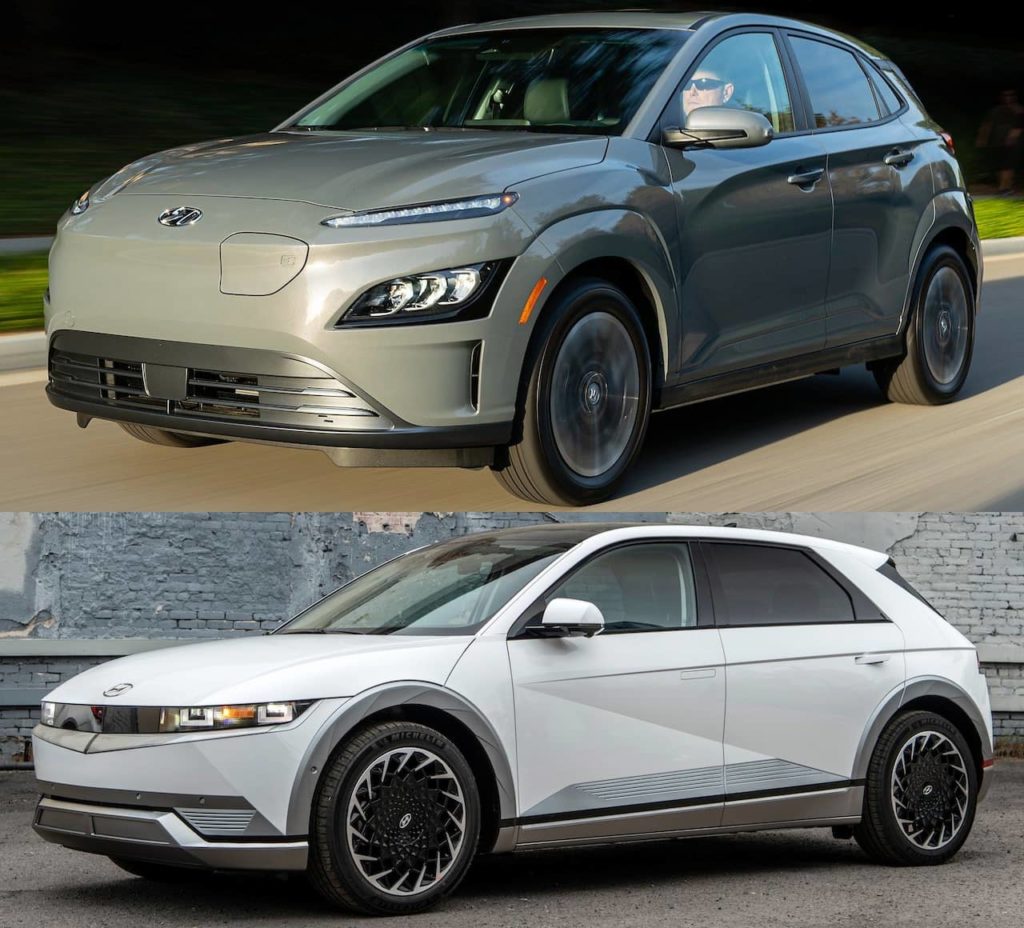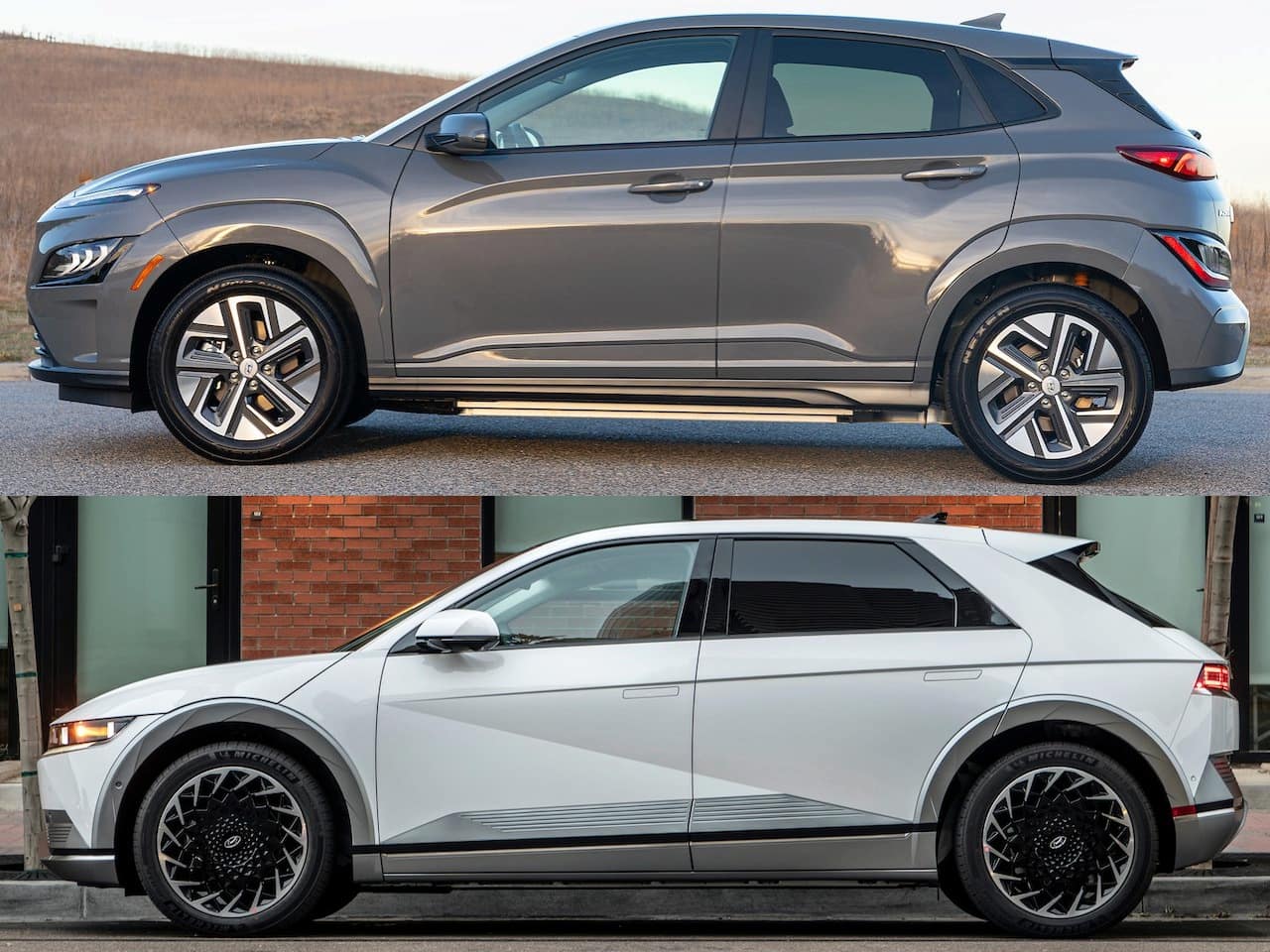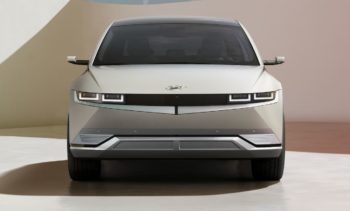The Hyundai Kona EV and Hyundai Ioniq 5 belong to different segments and accordingly have different positioning in the market. However, some customers and EV enthusiasts are mistakenly seeing them as if one is an alternative. This article compares both Hyundai electric car models to understand what sets them apart.
Dimensions
Measuring 165.6 in length, 70.9 in width, and 61.2 in height, the Hyundai Kona EV is a sub-compact SUV. At 182.5 in. long, 74.4 in. wide, and 63.0 in. tall, the Hyundai Ioniq 5 is a compact SUV. It’s noticeably bigger and significantly more spacious. The latter is not just because it’s a higher-segment model with a longer, wider, and taller body, but also the fact that it’s a model developed as an EV from the outset on a bespoke platform. Its wheelbase is almost four inches longer than that of the Palisade – the biggest model Hyundai offers in the U.S.
| Dimension | Hyundai Kona EV Specification | Hyundai Ioniq 5 Specification |
| Length | 165.6 in. | 182.5 in. |
| Width | 70.9 in. | 74.4 in. |
| Height | 61.2 in. | 63.0 in. |
| Wheelbase | 102.4 in. | 118.1 in. |
| Cargo Capacity (Rear Seats Up/Rear SeatsFolded Down) | 19.2 cu. ft./45.8 cu. ft. | 27.2 cu. ft./59.3 cu. ft. |
| Front Cargo (Frunk) Capacity | – | 0.85 cu. ft. |
| Passenger Interior Volume | TBD | 106.5 cu. ft. |
Design
On the design front, both Kona EV and Ioniq 5 are soft-looking crossovers. However, while the former is curvy and fluidic, and funky, the latter is sharp, squarish, and bold. The small SUV has written fun all over, and the compact SUV is fun, too, even more so, but it doesn’t show that off explicitly.

It would be technically incorrect to say the Ioniq 5 has a neo-retro character. That’s because, along with the old elements derived from the 1974 Hyundai Pony Coupe concept – the same model that influenced the iconic DeLorean DMC 12, it clubs not a modern, current-era design but a futuristic design. The pixelated headlamps and rear combination lamps, the V-shaped positioning lamps, and, in select markets, the camera-based, fender-mounted ORVMs and the solar roof give the Ioniq 5 a very futuristic design.
Inside, both Kona Electric and Ioniq 5 have a minimalist design. Still, the latter takes it a notch above with its two-spoke steering, dual-screen panel, slimmer dashboard, and smaller center console panel. Being a bespoke EV, it’s more practical, too. For example, the front center console slides back and forth 5.5 inches. The rear seats also provide more versatility, being slidable forward up to 5.3 inches and reclinable, too.

Specifications
This is where the Ioniq 5 is way ahead of the Kona Electric. While the small SUV sits on a modified ICE platform, the compact SUV’s base is the EV-specific E-GMP platform. E-GMP is one of the most sophisticated EV platforms for mainstream brands in the market right now.
The U.S.-spec Kona Electric is available in just one technical configuration. A single PMSM generating 150 kW (201 hp) and 291 lb.-ft. propels the front wheels. An LG Chem-made 64.0 kWh battery pack supplies it the energy. It provides a range of 258 miles (EPA est.). Level 2 charging (10-100% SoC) takes approx. 9 hours 15 minutes and Level 3 charging (10-80%) as less as approx. 47 minutes.

The U.S.-spec Ioniq 5 is available in three different technical configurations: two battery pack options and three powertrain options: Standard Range RWD, Long Range RWD, and Long Range AWD. The Standard Range RWD variant uses a 58.0 kWh battery pack, while the other two variants have a 77.4 kWh battery pack, both sourced from SK Innovation.
The Standard Range RWD variant has a single, 168 hp/268 lb.-ft. motor and can travel up to 220 miles (EPA est.) on a full charge. The Long Range RWD variant offers more punch with a 225 hp/258 lb.-ft. Its range is 303 miles (EPA est.). The Long Range AWD variant sports a dual-motor powertrain that produces 320 hp and 446 lb.-ft. of torque, and its range is 256 miles (EPA est.).
| Aspect | Hyundai Kona EV | Hyundai Ioniq 5 |
| Drivetrain Layout | FWD | RWD/AWD |
| No. of Motors | One (Front) | One (Rear)/Two (Front and Rear) |
| Motor Max. Power | 201 hp | Up to 320 hp |
| Motor Max. Torque | 291 lb.-ft. | Up to 446 lb.-ft. |
| Top Speed | 104 mph | 115 mph |
| Battery Pack Energy Content | 64 kWh | Up to 77.4 kWh |
| Range (WLTP) | Up to 300 miles | Up to 303 miles |
| On Board Charger | 10.5 kW Three-Phase | 10.5 kW Three-Phase |
| 800-volt charging support | No | Yes |
| DC Fast-Charging Time (10 to 80% SoC) | ~47 minutes | 18 minutes |
According to Hyundai’s product guide, Level 2 charging (10-100% SoC) in the Ioniq 5’s 77.4 kWh variants takes 6 hours 43 minutes. Level 3 charging in these variants takes just 18 minutes in these variants, thanks to their 800-volt charging capability. The company is yet to publish the charging times of the 58.0 kWh variant.
Unlike the Kona EV, the Ioniq 5 supports bidirectional charging as well. This means customers can power their home, power tools, portable electronics, and even another EV with the energy stored in the Ioniq 5’s battery pack.
Price

This isn’t a fair comparison as the Hyundai Ioniq 5 is superior to the Hyundai Kona EV in all respects. But with its better capabilities comes a higher asking price. While Kona Electric ranges between USD 34,000 and 42,500, the Ioniq 5’s prices start at USD 39,700 and go up to USD 54,500. In addition to being more expensive, the loniq 5’s supply is extremely limited. Moreover, it is available in only select states, as listed below:
- Arizona
- California
- Colorado
- Connecticut
- Florida
- Georgia
- Massachusetts
- Maryland
- North Carolina
- New Jersey
- New Mexico
- New York
- Oklahoma
- Oregon
- Pennsylvania
- Texas
- Virginia
- Washington
Featured Image Source: Hyundai Motor Group

![Compact Hyundai ‘Ioniq 3’ to be produced in Singapore in 2025 [Update]](https://electricvehicleweb.com/wp-content/uploads/2022/01/2025-Hyundai-Ioniq-3-rendering-front-350x220.jpg)
![Hyundai Ioniq 6 spied in production form for the first time [Update]](https://electricvehicleweb.com/wp-content/uploads/2021/09/Hyundai-Ioniq-6-front-rendering-350x197.jpg)
